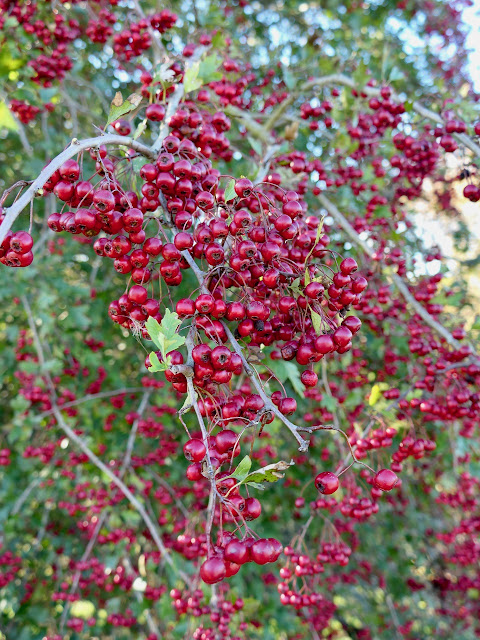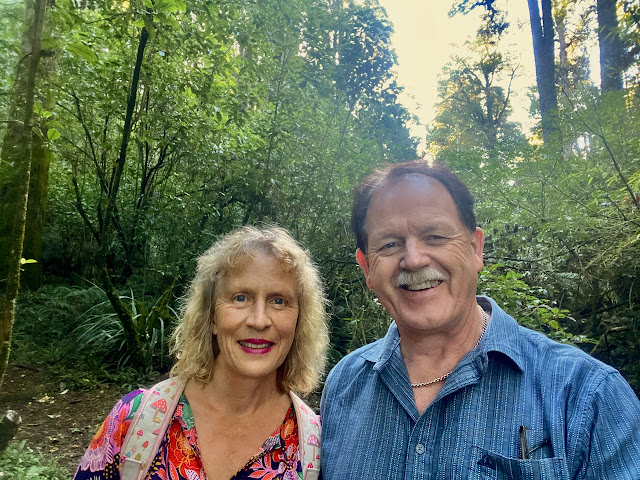26th April 2024
Well here I am scrabbling to catch up with all our adventures as a glorious April provided a perfect opportunity to get out and about and we went all over the place. And it's now early June. It makes you realise just how the seasons keep moving- life ever evolving and best we move with it.
"I'm quite keen on this idea of a birthday "season"- saves a lot of disappointment in many ways. And after all- what if you didn't get to have a whole lot more of them! So Last Sunday I bought cornflakes!! Took me a while to find them but they are necessary if you fancy making the fave afghan biscuits. Then on Wednesday we headed out the back of Taradale, up through Rissington, on to Puketitiri & Ball's Clearing- a wonderful bush reserve. We hadn't been out this way since the cyclone. Some residents lost their homes & all were cut off for months when the Rissington bridge got washed away. So we were thrilled to find the reserve in amazingly robust health. Coming upon loads of hawthorn trees still holding their wonderful crimson berries was such a joy." 
I don't think we're here just to repeat things endlessly, besides which the land seldom lets that happen; whether we like it or not. We've discovered through our wildcrafting adventures, no season unfolds in exactly the same way and sometimes you get just the one opportunity and that's that! Like meeting the most beautiful hawthorns out on Stock road in Havelock North about three years ago. I adored those trees and they produced the most marvelous berries. Then one day I drove out that way and found that they were gone. Unwanted. Eliminated.
So when we headed up through Puketitiri on this excursion we were so delighted to find late fruiting hawthorns- this one tucked in with a coprosma (karamu), the edible orange berries alongside.
In the same vicinity we also spotted tutu, a native plant that is very attractive but pretty jolly poisonous.
I keep reminding myself that just because something looks edible, or pretty doesn't necessarily make it so. It may just be unpalatable, or it could make you crook. Worst case scenario- it might kill you. Tutu might kill you.
There's tutu all over the place in Hawke's Bay so it's a good one to teach the whole family about.
Then suddenly I spotted this glorious hawthorn tree in full fruit, near the road and with a safe parking spot just nearby. Ironically these vibrant crimson berries are pretty unpalatable just as they are and the tree darn prickly, yet the haws are so full of heart nourishing goodness and medicine.
I think some plants have us in training. You cannot pick haws quickly- ever. Those thorns will keep you in line every time.
Yet the joy and comfort that we so frequently experience when visiting with hawthorns is priceless.
These berries are very late in the season
and truly magnificent.
Glory!
Such generosity.
The observers.
A little further up the road we arrived at the scenic bush reserve called Ball's Clearing. There are some grand old poplars here, which makes this a perfect spot for a picnic.
Out came the the birthday afghans.
.jpeg)
And the bees came to sniff our fragrant tea
and explore the yarrow.
We were so relieved to find that this forest was still standing.
It's a pretty special place.
Little by little we are learning our native plants. There's a good lot of happy Horopito up here- the New Zealand pepper tree. More a bush really. Horopito is both a culinary herb and also useful medicinally. Felicity of
Homegrown Botanica says this of Horopito:
"Horopito is another spicey pepper plant, it has a lot of heat which lingers on your tongue and is definitely not for the faint hearted! Taste a very little bit first, and wait 30 seconds because it can take awhile for the heat to hit you.
Many studies have proven Horopito to be more powerful anti fungal than prescription steroid creams, and I use this in my anti-fungal balm."I have even heard of people managing to walk out of the bush after an injury and chewing Horopito for the pain relief it affords, or perhaps it was the heat in the mouth that was a distraction.I hope I remember this time that these flowers belong to the native
coprosma grandifolia, Konono.
That's the thing with a lot of native shrubs and trees- they're not very distinctive. I've noticed this foliage many times but it's not until you see the fascinating flowers that you've really got something to distinguish this plant.
So this forest was saved by a petition in 1930s. Apparently the 1223 signatures were written on an impressive roll of paper. Well, thank goodness they all signed. I imagine the roll had to be carted around the place to acquire the supporting signatures and then someone undertook the long journey all the way to Wellington to physically present it to Parliament. The 1930s- not even a hundred years ago. Goodness, even I am now 63!
So much moisture in the forest- fosters fungi.
All over the place.
It's a fascinating thing to learn about the mychorizal networks that flourish in forests.
"Walking through the forest, it’s easiest to pay attention to what is happening at eye level and above. Birds, sunlight, wind, branches, there’s a lot to observe. Next time you’re exploring a forest, consider what lies below the soil, leaves, and moss that carpet the ground. Underneath the forest floor, intertwined with the roots of the trees, is a fascinating microscopic network of fungus.
When most of us think of fungus, we imagine mushrooms sprouting out of the ground. Those mushrooms are in fact the “fruit” of the fungus, while the majority of the fungal organism lives in the soil interwoven with tree roots as a vast network of mycelium. Mycelium are incredibly tiny “threads” of the greater fungal organism that wrap around or bore into tree roots. Taken together, myecelium composes what’s called a “mycorrhizal network,” which connects individual plants together to transfer water, nitrogen, carbon and other minerals. German forester Peter Wohlleben dubbed this network the “woodwide web,” as it is through the mycelium that trees “communicate.”
The above quote came from just here, if you'd like to read more. Very little native forest remains in Hawke's Bay. Actually it's a province that has seen quite a metamorphosis over the years. The 1931 earthquake created the reality of Napier city as it is today. So the forests and native trees we do have are a taonga (treasure) for sure and each spot has it's own preferences and style. Up here at Ball's Clearing there's a predominance of podocarps, Matai, Miro, Kahikatea and even Rimu. There's an interesting article just
here with many of the plants named carefully. I think this canopy might be Tawa.
Life and death in the forest- more life in death!
Still standing in death and nourishing in to the network.
A beautiful green canopy.
Since this is a remnant forest there are strange interfaces like this abrupt bursting out to pasture land.
Where there are fodder crops growing.
An explanation for this juxtaposition.

On this margin it's easy to spot the grassy green elegance of Rimu and all along this boundary we found various versions of the native grabby climber Tataramoa- also known as Bush Lawyer.
This one is probably swamp lawyer. Rubus australis.
And this one you would not want to fall in to that's for sure as it would never let you go!
Bush Lawyer- Rubus cissoides.
Rimu.
This plant is quite fascinating and found along the paddock margin to Ball's Clearing.
Umbrella fer
n, Sticherus cunninghamii.Those who wear dresses.
"New Zealand’s tallest tree fern is not to be mistaken for the ponga or silver. As the old fronds die off to make way for the new emerging fronds, they are often seen draping around the trunk.Maori have long referred to the mamaku as originally being a woman, but because of constant quarrelling with her husband Toroa, and the refuted warnings to stop by the Patupaiarehi (ancient fairy people), as it disturbed the peacefulness of the forest environment, she was turned into the mamaku tree fern, to stand silently.
The dead fronds drooping from her body are likened to her hair hanging in sadness because of this outcome...." You can find more about the edible and medicinal uses of Mamaku just here.
Reading a little about the vulnerability of this forest remnant barely a century ago I feel confidant that there is finally respect and care here in this place where the glory shines through.
Busy forest spidery!
And lots of Wall lettuce (Mycelis muralis) in the margins of the forest and some places on the forest floor. A useful edible plant- should you ever have need of sustenance; much like puha.
Finding Miro on our way out.
At first I thought these seeds were native passionfruit (about the same size and colour) but no they are Miro seeds. Fancy that- holding the promise and DNA of a forest giant in the palm of my hand.

On our way down we had a good view of the hawthorn grove- friends of our abundant tree.
All berries and no leaves!
Then down, down, down to home...
and looking up to see the full moon rising was pretty special too.
The season isn't over yet- there are more plans for this week. And cake!








.jpeg)


.jpeg)



.jpeg)
























.jpeg)








.jpeg)

.jpg)
.jpeg)



.jpeg)
No comments:
Post a Comment